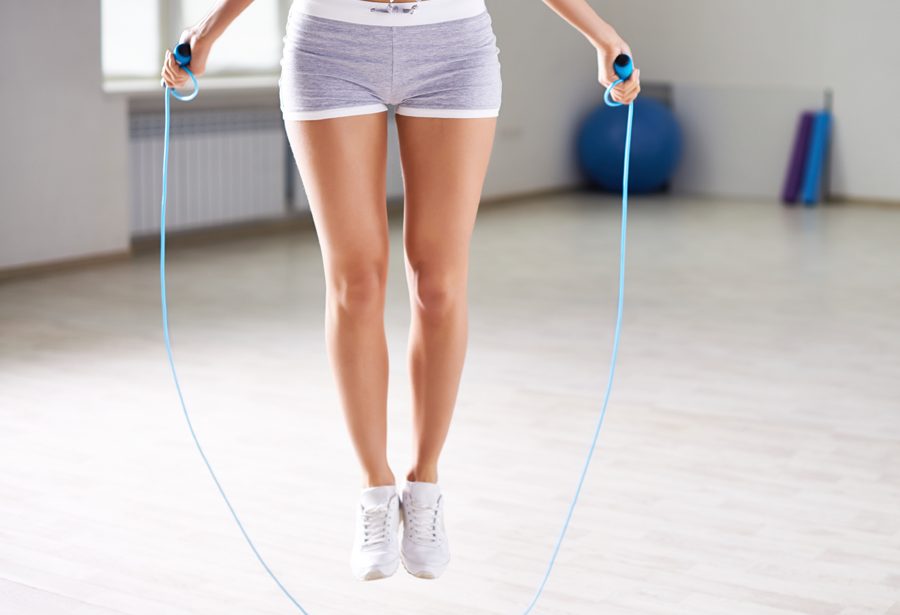That’s right, a blast from the past!
Some of us haven’t picked up a skipping rope since our primary school days, but did you know that skipping or ‘jump rope’ is one of the most effective forms of cardio?
Not to mention, it’s probably the cheapest piece of equipment for your workout.
Start Skipping!
Jump rope has been around for centuries in many cultures around the world, primarily as a children’s game.
But, mind you: you don’t have to be a child or an athlete to start skipping!
Today, fitness centres often incorporate jumping rope as part of a cardio workout. Jumping rope is also integrated into various exercise routines, such as pilates, kickboxing and boxing. Many team sports training programmes incorporate it as a warm-up and conditioning tool for improving overall athletic performance.
Assuming you’re in relatively good health, there’s really no excuse about “not having time to get to the gym” when you can slip a rope into your handbag, backpack or briefcase and get cracking whenever you have a free moment.
Sure… you may get some strange looks if you whip it out while you’re at the office, or waiting on the bus route for transport, but you’ll be the one having the last laugh, as you skip your way into a fitter, leaner and more powerful body.
Here are a few benefits of skipping:
- It’s one of the best cardiovascular exercises and High-intensity Interval Training workouts. It is also excellent for endurance training and conditioning.
- Skipping exercises put less pressure on the joints than running. The impact of each jump is absorbed by the balls of both feet rather than the heels, which reduce the ground reaction forces through the patella-femoral joint.
- It is beneficial for blood pressure patients, as it improves cardiovascular health by improving the heart beat rate.
- It’s also excellent if your goal is to lose weight. If you keep up a moderate to high pace, you can burn anywhere from 500-1300 calories an hour. (You’d have to be a cardio beast to keep jumping for an hour straight, so unless you’re an athlete, it’s best to break this down into spurts of 5 or 10 mins at a time.)
- Skipping is more effective at burning calories than running — and, you don’t need even need to go outdoors to do it. Note: many professional athletes use jump rope as part of their training, so this should tell you how effective it can be!
- It is a full-body workout that tones muscles in the entire body, developing long, lean muscles in all major muscle groups, both upper and lower — particularly on your thighs, shins and calf muscles. It also engages your hip-flexor muscles, abs, and arms.
- If you are generally a klutz by nature, skipping is a good exercise to improve your footwork, balance, coordination and agility.
- Skipping can be done by anyone from beginners to advanced level. It is an good form of exercise for the family to enjoy together.
Tips for Your Skipping Workout:
- Make sure to buy a good quality rope, to avoid breakages that may hurt you. Ropes with weighted handles can help burn more calories, but they can be cumbersome and are not recommended for a beginner. Also, choose the correct length of rope that you feel comfortable with. To choose the right length rope for you: step one foot on the centre of the rope and bring both handles up. The handles should reach chest-high.
- Ladies, you should wear a good high impact sports bra; men, make sure your delicate regions are also well supported! Skipping causes a lot of body movement. If you do not wear a good sports bra, then it can cause tears in the breast muscles, resulting in sagging breasts. Men, it goes without saying that you’ll be more than anxious to protect your family jewels as well.
- Wear good sports shoes to absorb the shock of your feet meeting the ground repeatedly. Whatever shoe you decide on, make sure they have a reinforced toe and provide extra cushioning for the ball of the foot.
Choose a good surface that is even and absorbs shock well, with high ceilings or an open sky. Wooden floors or other smooth surfaces are best to avoid injury.
- Diving into a high-intensity workout is never a good idea. Start off small and work your way up to faster, longer durations of skipping. This is best for your heart and joints.
- Jump low to keep the impact on your knees and ankles to a minimum. Roll up to the balls of your feet to push off and land lightly back on the balls of your feet when you land so that your muscles share the load of impact along with your joints.
- Do a brief warm-up before you start jumping. A little on-the-spot jogging will help limber you up to start skipping.
- While resting in between set of skipping, alternate jumping with lower intensity exercise, such as marching — this will help you to be able to jump for longer periods.
A word of caution…
Finally, bear in mind that skipping isn’t for everyone, and pre-existing medical conditions can make you a bad candidate to be skipping regularly. This may include those with prior injuries to the knee or ankle, osteoporosis, those on certain medications, etc. Please check with your doctor first.

